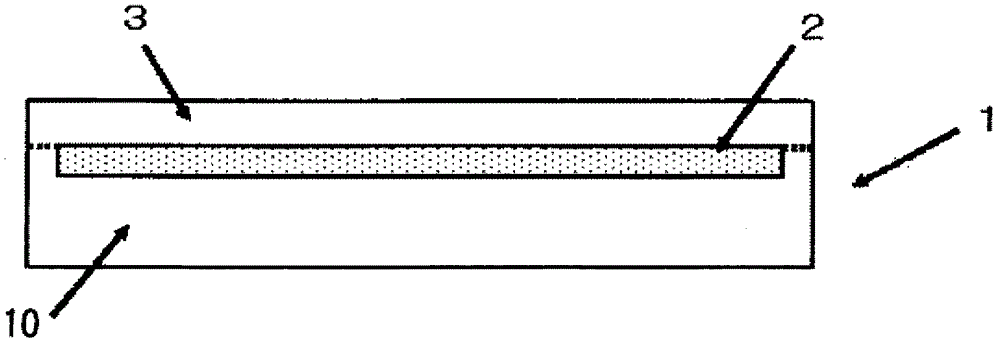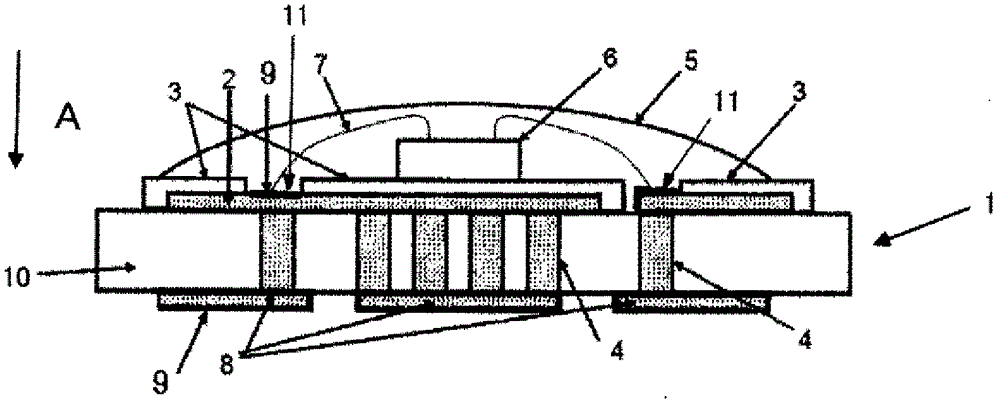Light-emitting Device
A technology for light-emitting devices and light-emitting components, which is used in transportation and packaging, thin material processing, electrical components, etc., to achieve the effects of preventing the decline of luminous efficiency, preventing corrosion, and having high thermal conductivity.
- Summary
- Abstract
- Description
- Claims
- Application Information
AI Technical Summary
Problems solved by technology
Method used
Image
Examples
Embodiment
[0077] A green sheet for forming a lower ceramic layer was produced by the following method. That is, to form SiO in mole % 2 60.4%, B 2 o 3 15.6%, Al 2 o 3 6%, CaO 15%, K 2 O is 1%, Na 2 Glass raw materials were blended and mixed at a composition of 2% O, and the mixed raw materials were put into a platinum crucible and melted at 1550 to 1600° C. for 60 minutes, and then the molten glass was poured out and cooled. The obtained glass was pulverized in ethanol for 20 to 60 hours using an alumina ball mill to obtain glass powder. The D of the powder was measured using SALD2100 manufactured by Shimadzu Corporation (Shimadzu Corporation). 50 , the result is 2.5 μm. The softening point Ts (unit: °C) and crystallization peak temperature Tc (unit: °C), as a result, Ts was not clear, and Tc was 850 °C.
[0078] Expressed in mass percent, according to the ratio of 40% for the above-mentioned glass powder and 60% for the aluminum oxide powder AL-45H produced by Showa Denko Cor...
example 1~ example 18
[0080] A glass-ceramic paste for forming an upper ceramic layer was produced by the following method. That is, each raw material is blended and mixed to form SiO 2 to ZrO 2 Compositions shown in mol % in the columns above, each mixed raw material was put into a platinum crucible and melted at 1550-1600° C. for 60 minutes, and then poured out the molten glass and cooled. The obtained glass was pulverized in ethanol for 20 to 60 hours using an alumina ball mill, and the same operation as above was performed to obtain glass powder. The D of each obtained glass powder was measured using SALD2100 manufactured by Shimadzu Corporation. 50 (unit: μm). In addition, the softening point Ts (unit: °C) and crystallization peak temperature Tc (unit: °C) were measured using a thermal analysis device TG-DTA2000 manufactured by Bruker AXS Co., Ltd. at a heating rate of 10 °C / min to 1000 °C. For the glass powder of each composition, the measured D 50 Each value of (unit: μm), softening poi...
PUM
| Property | Measurement | Unit |
|---|---|---|
| thickness | aaaaa | aaaaa |
| particle size | aaaaa | aaaaa |
| thickness | aaaaa | aaaaa |
Abstract
Description
Claims
Application Information
 Login to View More
Login to View More - R&D
- Intellectual Property
- Life Sciences
- Materials
- Tech Scout
- Unparalleled Data Quality
- Higher Quality Content
- 60% Fewer Hallucinations
Browse by: Latest US Patents, China's latest patents, Technical Efficacy Thesaurus, Application Domain, Technology Topic, Popular Technical Reports.
© 2025 PatSnap. All rights reserved.Legal|Privacy policy|Modern Slavery Act Transparency Statement|Sitemap|About US| Contact US: help@patsnap.com



